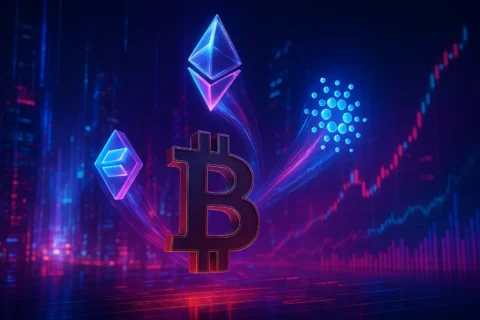Navigating the Ever-Evolving Crypto Terrain: An Altcoin Snapshot
The cryptocurrency market is a dynamic beast, constantly shifting, innovating, and presenting new opportunities. While Bitcoin often hogs the spotlight, the altcoin sector has become a vibrant ecosystem ripe for exploration. We’re witnessing a fascinating period where utility-driven altcoins are maturing alongside the explosive growth of meme coins, all while airdrop strategies continue to evolve as a primary user acquisition tool. Recently, we’ve seen significant volatility, with some altcoins experiencing unprecedented surges driven by strong community sentiment and speculative interest, while others have faded into obscurity.
H2: The Core Concept: How a Community Takeover Actually Fuels Altcoin Success
At its heart, the success of many altcoins, especially in the early stages, hinges on more than just innovative technology or clever tokenomics. It’s about building and empowering a community that becomes deeply invested in the project’s vision and actively participates in its growth and governance. This is what we refer to as a Community Takeover. It’s not just about having followers; it’s about fostering a loyal, engaged, and vocal group that advocates for the project, contributes to its development, and ultimately drives its adoption and value.
H3: What Are Altcoins, Meme Coins, and Airdrops?
To truly appreciate the power of a Community Takeover, we need to define our terms.
- Altcoins: This is a broad term encompassing any cryptocurrency other than Bitcoin. They emerged as alternatives to Bitcoin, often aiming to improve upon its perceived limitations or offer entirely new functionalities. Altcoins can range from sophisticated platforms powering decentralized applications (dApps) and smart contracts (like Ethereum, Solana, Cardano) to simpler cryptocurrencies designed for specific use cases or as digital currencies.
- Meme Coins: These are cryptocurrencies that originated from internet memes, jokes, or viral online trends. While often lacking fundamental utility in their early stages, meme coins like Dogecoin and Shiba Inu have demonstrated the immense power of community fervor and social media virality. Their success is largely community-driven, with a strong emphasis on social media engagement, online communities (often on Reddit, Discord, and Twitter), and a speculative, often humorous approach to investment. A robust Meme coin DAO can be instrumental in guiding these projects beyond their initial meme status.
- Airdrops: An airdrop is a marketing tactic where a cryptocurrency project distributes its tokens freely to a wide audience, often to existing holders of another cryptocurrency (like Bitcoin or Ethereum) or to users who perform specific tasks (e.g., joining a Telegram group, following on social media). Airdrops are primarily used to increase awareness, attract new users, and bootstrap a community around a new token or project. A successful airdrop can be the very first step in initiating a Community Takeover.

H3: Key Components & Technologies Driving Altcoin Innovation
The foundation of most altcoins lies in blockchain technology, the same distributed ledger system that powers Bitcoin. However, many altcoins have built upon this core technology to offer advanced features:
- Smart Contracts: Pioneered by Ethereum, smart contracts are self-executing contracts with the terms of the agreement directly written into code. They enable the creation of decentralized applications (dApps), DeFi protocols, NFTs, and much more, opening up a vast array of use cases for altcoins.
- Proof-of-Stake (PoS) and Other Consensus Mechanisms: While Bitcoin uses Proof-of-Work (PoW), many altcoins, particularly newer ones, utilize energy-efficient consensus mechanisms like Proof-of-Stake (PoS). PoS often allows token holders to stake their coins to validate transactions and earn rewards, directly involving the community in network security and creating a vested interest.
- Decentralized Finance (DeFi): DeFi protocols built on altcoin blockchains offer a range of financial services without traditional intermediaries. This includes lending, borrowing, decentralized exchanges (DEXs), and yield farming, all powered by smart contracts and often incentivizing community participation.
- Interoperability Solutions: As the crypto space matures, altcoins are increasingly focusing on interoperability – the ability for different blockchains to communicate and exchange data. Projects like Polkadot and Cosmos are building the infrastructure for a multi-chain future, where seamless asset and data transfer is crucial.
- Decentralized Autonomous Organizations (DAOs): DAOs are a crucial element in fostering a Community Takeover. They represent a new form of organizational structure where decisions are made collectively by token holders through proposals and voting. This decentralized governance model ensures that the community has a genuine say in the project’s future, from treasury management to protocol upgrades.
H2: The Data-Driven Perspective: Quantifying Altcoin Potential
To move beyond speculation, we need to look at the numbers. The performance of altcoins, meme coins, and the impact of airdrops can be assessed through various data points.
H3: Altcoin Market Data & Trends: Beyond the Hype
Analyzing market data provides a clearer picture of altcoin performance and potential.
- Altcoin Market Cap Growth: Data from CoinMarketCap and Coinpaprika shows that the total market capitalization of altcoins (excluding Bitcoin) has seen periods of explosive growth, often outpacing Bitcoin’s gains during bull markets. For example, during the 2021 bull run, many altcoins experienced triple-digit percentage increases in a matter of weeks.
- Trading Volumes: Increased trading volume for an altcoin can indicate growing interest and liquidity, making it easier for investors to buy and sell without significantly impacting the price. High volumes, especially when correlated with positive news or community activity, are strong indicators of momentum.
- DeFi TVL on Alternative Blockchains: As mentioned earlier, the Total Value Locked (TVL) in DeFi protocols on blockchains like Ethereum, Solana, Avalanche, and Polygon has been a significant indicator of their ecosystem’s health and user adoption. A growing TVL suggests that users are actively participating in DeFi activities, which often necessitates holding the native altcoin. For instance, the rise of Layer-2 scaling solutions has seen a surge in TVL, driving demand for their respective native tokens.
- Airdrop Participation Rates: Analyzing the number of wallet addresses participating in airdrops provides insight into the effectiveness of a project’s distribution strategy in attracting users. Projects that see high participation rates often benefit from a larger initial community base. Data from airdrop aggregators often highlights trends in which types of tokens or chains are most popular for airdrops.
H3: Tokenomics & Market Health: The Backbone of Value
Tokenomics refers to the economics of a cryptocurrency token. It’s the design that governs its supply, distribution, utility, and demand, fundamentally influencing its value and long-term sustainability.
- Supply and Demand: A limited supply, coupled with increasing utility and demand, is a classic economic principle that can drive up an altcoin’s price. Conversely, an inflationary token supply or lack of clear use cases can suppress value. For example, projects with deflationary mechanisms, like token burns, often see price appreciation as the circulating supply reduces.
- Utility and Use Cases: Does the altcoin solve a problem? Does it have a real-world application or power a thriving ecosystem? Altcoins with strong utility, such as those powering dApps, providing transaction fees on popular networks, or facilitating unique services, tend to have more sustainable value propositions. Data on active users of dApps on a specific blockchain is a strong indicator of the altcoin’s utility.
- Distribution and Vesting Schedules: Fair distribution of tokens is crucial for community trust. Projects with a significant portion of tokens concentrated in a few wallets can be seen as risky. Vesting schedules for team and early investors prevent large sell-offs that could crash the price. A Community Takeover is significantly more likely when the community believes the token distribution is equitable.
- Staking Rewards and Incentives: Altcoins that offer attractive staking rewards can incentivize long-term holding and participation, reducing selling pressure and locking up a significant portion of the supply. This can be a powerful tool for community engagement and price stability.
H2: Risks, Challenges, and the Competitive Landscape
While the potential rewards of altcoins are significant, understanding the inherent risks and competitive environment is paramount.
H3: The Perils of Altcoins and Meme Coins: Navigating the Minefield
Investing in altcoins, especially newer or meme-focused ones, comes with considerable risks:
- Extreme Volatility: Altcoins are generally far more volatile than Bitcoin. Their prices can swing dramatically based on market sentiment, news, or even social media trends, leading to rapid and substantial losses.
- Security Vulnerabilities: Newer altcoins may have less tested code, making them susceptible to exploits, hacks, and smart contract bugs. A smart contract exploit can lead to a complete loss of funds for holders.
- Regulatory Uncertainty: The regulatory landscape for cryptocurrencies is still evolving globally. New regulations or crackdowns can significantly impact the price and future viability of certain altcoins.
- Lack of Liquidity: Many altcoins, particularly smaller ones, have low trading volumes, making it difficult to buy or sell large amounts without impacting the price. This can trap investors in positions.
- Scams and Rug Pulls: The decentralized nature of crypto also makes it a fertile ground for scams. “Rug pulls,” where developers abandon a project after raising funds, are a pervasive risk, especially within the meme coin space.
- “Hype” vs. “Utility”: Many meme coins, and even some altcoins, are driven purely by speculative hype. When the hype dies down, the price can collapse, leaving investors with significant losses. A strong community can sustain hype, but only utility can provide long-term value.
H3: How Altcoins Stack Up Against the Competition
The altcoin market is incredibly diverse, with each project vying for attention and adoption. Here’s a general comparison of how different categories of altcoins fare against established players and each other:
| Feature | Bitcoin (BTC) | Major Altcoins (e.g., ETH, SOL) | Meme Coins (e.g., DOGE, SHIB) | Emerging Altcoins/New Projects |
|---|---|---|---|---|
| Primary Focus | Digital Gold, Store of Value | Smart Contracts, dApps, DeFi, NFTs, Ecosystems | Community-driven, Virality, Speculation | Varies widely: DeFi, Layer-1s, Layer-2s, NFTs, Metaverse, Gaming, specific utility |
| Market Cap | Highest | High to Medium | Medium to Very High (but volatile) | Low to Medium |
| Volatility | Moderate (relative to altcoins) | High | Extremely High | Extremely High |
| Utility | Primarily store of value, payment network | High (powers complex applications) | Limited (community engagement is primary) | Varies greatly, often experimental or niche |
| Community Power | Strong, ideological | Developing, actively engaged | EXTREMELY High, social media driven | Crucial for survival and growth; potential for rapid Community Takeover |
| Risk Profile | Lower (relative to altcoins) | High | Very High | Very High (often highest risk) |
| Innovation | Primarily focused on security & stability | High (smart contracts, scaling, DeFi) | Relies on social engineering & trends | Varies; can be highly innovative or derivative |
As you can see, there’s a spectrum of risk and reward. Bitcoin offers stability, major altcoins provide functionality, meme coins offer high-risk, high-reward potential tied to community momentum, and emerging altcoins are often the most speculative but can also offer the highest potential upside if they capture community interest and demonstrate real innovation, potentially leading to a strong Community Takeover.
H2: The Future Outlook: What Lies Ahead for Altcoins, Meme Coins, and Airdrops?
The trajectory of altcoins, meme coins, and airdrop strategies is intrinsically linked to broader technological advancements and evolving investor behavior.
H3: What’s Next for the Altcoin Ecosystem?
- Increased Utility and Real-World Adoption: We can expect a greater emphasis on utility and tangible use cases for altcoins. Projects that offer genuine solutions to existing problems, integrate with real-world industries, or provide essential infrastructure for the decentralized web are likely to thrive.
- Interoperability and Scalability Solutions: As the blockchain space matures, interoperability between different chains will become increasingly critical. Altcoins focused on cross-chain communication, sharding, and efficient scaling solutions will likely gain prominence. This will pave the way for seamless user experiences and wider adoption across decentralized applications.
- Maturation of DeFi and NFTs: The DeFi and NFT sectors are still relatively nascent. As these areas mature, altcoins that underpin these ecosystems will benefit. We’ll likely see more sophisticated financial instruments, greater institutional involvement, and innovative use cases for NFTs beyond digital art, all of which will drive demand for specific altcoins.
- The Evolving Role of DAOs: DAOs will continue to shape the governance and direction of many altcoin projects. As DAOs become more sophisticated and legally recognized, they will empower communities to have a more significant say in project development, resource allocation, and treasury management. This decentralization of power is a key ingredient for a successful Community Takeover.
- Strategic Airdrops and Community Building: Airdrops will likely continue to be a vital tool for user acquisition and community bootstrapping. However, expect more targeted and sophisticated airdrop strategies, rewarding genuine network participation and early adopters, rather than simple bot campaigns.
For meme coins, the future remains largely tied to the whims of social media trends and community engagement. While some may fade, the most resilient could evolve by incorporating utility or adopting decentralized governance models through a Meme coin DAO, seeking legitimacy beyond their initial meme status.
H2: Conclusion: Empowering Your Altcoin Journey
The world of altcoins offers immense potential for those willing to do their research and understand the underlying dynamics. We’ve explored how a powerful Community Takeover is often the secret ingredient that separates fleeting hype from sustainable success. From understanding the foundational technologies and tokenomics to navigating the inherent risks and looking towards future trends, informed investment is key.
Remember, success in altcoins isn’t just about picking the next big project; it’s about understanding how community, utility, and sound economic principles converge. Keep learning, stay curious, and engage with the projects you believe in.
What are your thoughts on the power of community in the altcoin space? Have you ever been part of a project that experienced a true Community Takeover? Share your experiences and predictions in the comments below! Don’t forget to subscribe for more in-depth crypto analysis and actionable strategies.
H2: Frequently Asked Questions (FAQs)
1. What is the most important factor for altcoin success?
While many factors contribute, a strong, engaged, and dedicated community is often the most crucial element for sustainable altcoin success, enabling a powerful Community Takeover. Real-world utility and sound tokenomics are also vital.
2. How can I identify a promising altcoin?
Look for projects with clear use cases, innovative technology, transparent development teams, well-defined tokenomics, and an active, positive community. Thoroughly research their whitepaper, roadmap, and on-chain data.
3. Are meme coins a good investment?
Meme coins are highly speculative and extremely volatile. They are generally considered a high-risk investment, suitable only for those who can afford to lose their entire investment. Their success is often driven by hype and social media trends.
4. What is the risk of an airdrop?
The primary risks of airdrops include security threats (phishing scams disguised as airdrops) and the potential for the token received to have little to no value. Always verify the authenticity of an airdrop and never share your private keys.
5. How do DAOs contribute to altcoin success?
DAOs and Meme coin DAO structures allow token holders to participate in governance, vote on proposals, and steer the project’s direction. This decentralizes decision-making, fosters community ownership, and can lead to more robust development and adoption, a key aspect of a successful Community Takeover.
6. What is a “rug pull”?
A rug pull is a type of exit scam where cryptocurrency developers abandon a project after raising funds from investors. They often do this by removing liquidity from the decentralized exchange, causing the token’s price to plummet to zero.
7. How much of my portfolio should I allocate to altcoins?
This depends entirely on your risk tolerance. Beginners are often advised to start with a smaller allocation, focusing on well-established altcoins with strong fundamentals, before considering more speculative investments. Diversification is key.






